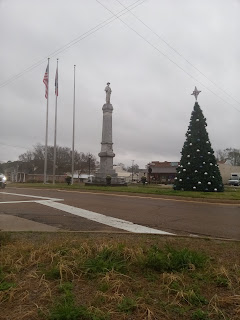As a child, I knew "Mush", aka "Corn Meal Mush", as a hot breakfast cereal. Just corn meal cooked/boiled in water with some pork fat. Or maybe butter. Left over mush could be sliced and fried and eaten with other meals. Frederick Olmsted wrote of his travels across early Texas (and other parts of The South) 1852-1857. He described in detail Texas life of the time. Corn was a prime dietary feature for both humans and animals. In the middle of summer, dried corn on the ear was stored away in corn cribs and great efforts ensued to keep the rodents and insects out of it. As needed, it was ground for near term use in cornbread, mush, and hoecakes. Travelers, such as Olmsted, were generally put up by widely separated farmers and the travelers shared the food of the farmers. As the harvest of the next corn crop approached, the previous crop not yet fed to humans or animals was likely used to make moonshine.
https://en.wikipedia.org/wiki/Frederick_Law_Olmsted
https://www.eater.com/2015/9/1/9211867/scrapple-goetta-livermush-what-is-it
I had previously made some comments on other (than corn) subsistence crops. But the comments got lost somewhere along the way. To replace: Hogs and cane are similar to corn. Hogs are killed at "hog killing time" which is late Fall when it is cool enough to avoid hog meat rotting while waiting to be processed/cured. Hogs parts/products were preserved for a year or more via smoking, salt curing, sugar curing and combinations. Hog fat was rendered and put to long time use in cooking, soap making, etc. A side product is "chittlins" (fried pork rinds). Sugar cane ("Ribbon Cane" is a favored variety) was processed into syrup. Syrup making requires effort and equipment and was mostly performed by a specialist in the community. Like a miller. Families grew a patch of cane, then harvested and hauled it (in the Fall/Winter) to the syrup maker who typically did the work in exchange for a fraction of the product. Like millers did with corn and other grains. In The South, syrup made from cane is typically called "cane syrup", or maybe "ribbon cane syrup", but is sometimes called "cane molasses":
https://en.wikipedia.org/wiki/Molasses
In early 1800s up until transportation became faster and cheaper, in Texas and the rest of The South, Cotton was the cash crop. EVERYONE grew cotton. Most other crops were for home or local use. Cotton was sold. Other crops allowed the cotton farmers to feed themselves. Emigration to Texas was, in large part, due to old farm land in other parts of The South being "cottoned out". With repeated, not rotated, cotton planted year after year, the soil lost it's ability to produce profitable cotton crops and became almost valueless. At least in the short term.


